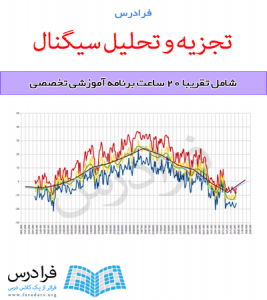آموزش تجزیه و تحلیل سیگنال

شناخت ویژگی های سیگنال های حوزه زمان پیوسته و گسسته مقدمه و پیش نیاز شناخت دنیای مخابرات است و طراحی صحیح ابزارهای مخابراتی و تحلیل تکنولوژی های مخابراتی نیازمند تسلط بر ویژگی های سیگنال و سیستم است.

شناخت ویژگی های سیگنال های حوزه زمان پیوسته و گسسته مقدمه و پیش نیاز شناخت دنیای مخابرات است و طراحی صحیح ابزارهای مخابراتی و تحلیل تکنولوژی های مخابراتی نیازمند تسلط بر ویژگی های سیگنال و سیستم است.
برای مشاهده جزئیات و تهیه آموزش تجزیه و تحلیل سیگنال به این لینک (+) مراجعه نمایید.
فهرست سرفصل ها و رئوس مطالب مطرح شده در این مجموعه آموزشی، در ادامه آمده است:
- درس یکم: معرفی سیگنال ها
- سیگنال زمان پیوسته
- سیگنال زمان گسسته
- سیگنال های پرکاربرد
- عملیات بر روی سیگنال ها
- سیگنال متناوب
- سیستم و خوای سیستم
- درس دوم: سیستم های LTI
- بسط سیگنال بر حسب توابع ضربه
- جمع کانولوشن و خواص آن
- انتگرال کانولوشن
- معادلات تفاضلی در سیستم های LTI
- پایداری سیستم ها
- درس سوم: سری فوریه
- سری فوریه زمان سیگنال پیوسته
- سری فوریه سیگنال زمان گسسته
- ویژگی های سری فوریه
- درس چهارم: تبدیلات فوریه
- تبدیل فوریه زمان پیوسته
- تبدیل فوریه زمان گسسته
- ویژگی های تبدیلات فوریه
- درس پنجم: نمونه برداری و بازسازی
- انواع نمونه برداری از سیگنال
- نحوه و شرایط بازسازی سیگنال
- درس ششم: تبدیل لاپلاس
- ناحیه همگرایی در تبدیل لاپلاس
- تبدیل لاپلاس و خواص آن
- معکوس تبدیل لاپلاس
- درس هفتم: تبدیل Z
- ناحیه همگرایی در تبدیل Z
- تبدیل Z و خواص آن
- معکوس تبدیل Z و ویژگی های آن
برای مشاهده جزئیات و تهیه آموزش تجزیه و تحلیل سیگنال به این لینک (+) مراجعه نمایید.
مفید برای رشته های
- مهندسی برق
- مهندسی الکترونیک
- مهندسی مخابرات و دیجیتال
پیش نیازهای علمی
- ریاضیات مهندسی
- معادلات دیفرانسیل
مجموعه: پردازش سیگنال, سته بندی مستقل, مهندسی برق برچسب ها: انتگرال, توابع ضربه, زمان پیوسته, زمان گسسته, سیستم های LTI, سیستم و خوای سیستم, سیگنال, سیگنال متناوب, سیگنال های پرکاربرد, عملیات, کانولوشن




 (No Ratings Yet)
(No Ratings Yet)